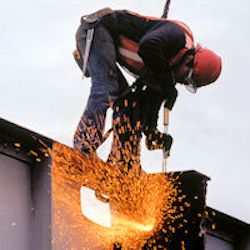Personal Protection
Fall Protection
A welder or helper working on platforms, scaffolds, or runways must be protected against falling. This may be accomplished by the use of railings, safety belts, life lines, or some other equally effective safeguards.

Although OSHA does not specify fall protection requirements in 1910.252(b), fall protection for welding and other work is detailed in other OSHA regulations:
- In general industry, 1910.28 requires fall protection when working 4 feet or more above a lower surface.
- In construction, 1926.501 requires fall protection when working 6 feet or more above a lower surface.
- In general industry and construction, fall protection is required when working at any height above dangerous equipment.
So, the question is, at which height must a welder use fall protection if welding above a lower level? The answer is at any height, depending on the nature of the hazard.
Real-Life Accident
In 2014, a worker was engaged in welding while positioned on a mast scaffold. He finished working in one area, unhooked his fall protection safety device, a double lanyard, and began to transit from the west end of the scaffold. According to witnesses, he tripped over the welder. He fell downward feet first, hitting the small welding platform and then an extended part of the building called a "bumpout." The area that he fell through was 14 feet long and 55 inches from the building. He then fell to the asphalt surface below, which was a fall height of 75 feet 6 inches. The worker died in the fall.
Knowledge Check Choose the best answer for the question.
6-1. At what height will a welder be required to use fall protection when working above dangerous equipment?
You forgot to answer the question!
